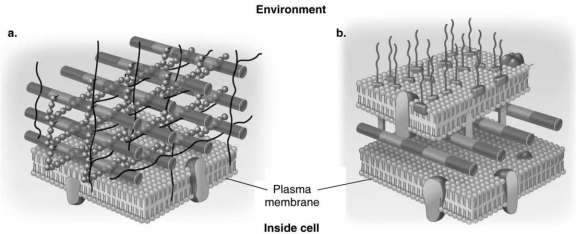A) a
B) b
C) both a and b
D) neither a nor b
E) The answer cannot be determined based on the information provided.
G) C) and E)
Correct Answer

verified
Correct Answer
verified
Multiple Choice
In bacteria, photosynthetic pigments are found in
A) chloroplasts.
B) chromatophores.
C) cytoplasm.
D) mesosomes.
E) ribosomes.
G) None of the above
Correct Answer

verified
Correct Answer
verified
Multiple Choice
Functions of the glycocalyx include all of the following EXCEPT
A) biofilm formation.
B) protection against dehydration.
C) source of nutrition.
D) binary fission.
E) increased virulence.
G) A) and C)
Correct Answer

verified
Correct Answer
verified
True/False
The internal structure of eukaryotic cilia and flagella are the same.
B) False
Correct Answer

verified
Correct Answer
verified
Multiple Choice
In a hypertonic solution, a bacterial cell will typically
A) lyse.
B) plasmolyze.
C) stay the same.
D) osmolyze.
E) burst.
G) A) and C)
Correct Answer

verified
Correct Answer
verified
Multiple Choice
Figure 4.3
 -In Figure 4.3, which diagram of a cell wall contains teichoic acids?
-In Figure 4.3, which diagram of a cell wall contains teichoic acids?
A) a
B) b
C) both a and b
D) neither a nor b
E) The answer cannot be determined based on the information provided.
G) A) and C)
Correct Answer

verified
Correct Answer
verified
Multiple Choice
The difference between simple diffusion and facilitated diffusion is that facilitated diffusion
A) moves materials from a lower to a higher concentration.
B) moves materials from a higher to a lower concentration.
C) does not require ATP.
D) requires transporter proteins.
E) requires ATP.
G) A) and B)
Correct Answer

verified
Correct Answer
verified
Multiple Choice
Which of the following statements is TRUE?
A) A cell produces one endospore and keeps growing.
B) Endospores allow a cell to survive environmental changes by producing a dormant period with no growth.
C) A cell can produce many endospores.
D) Endospores are for reproduction.
E) Endospores are easily stained in a Gram stain.
G) A) and C)
Correct Answer

verified
Correct Answer
verified
Multiple Choice
Which of the following pairs is mismatched?
A) centrosome food storage
B) lysosome digestive enzymes
C) Golgi complex secretion
D) mitochondria ATP production
E) endoplasmic reticulum internal transport
G) A) and E)
Correct Answer

verified
Correct Answer
verified
Multiple Choice
Antibiotics that target cell wall synthesis ultimately cause bacterial cell death as a result of
A) inhibition of molecular transport.
B) decreased synthesis of plasma membrane.
C) plasmolysis.
D) cell shrinkage.
E) osmotic lysis.
G) All of the above
Correct Answer

verified
Correct Answer
verified
Multiple Choice
Bacteria are a commonly used organism for studies of genetic material in the research laboratory. The nucleic acids must first be isolated from the cells for these studies. Which of the following would most likely be used to lyse gram-positive bacterial cells for nucleic acid isolation?
A) alcohol
B) lysozyme
C) polymixins
D) water
E) mycolic acid
G) B) and D)
Correct Answer

verified
Correct Answer
verified
Multiple Choice
How do spirochetes and spirilla differ?
A) Spirilla are found in chains of cells whereas spirochetes exist as individual cells.
B) Spirochetes have a rigid, corkscrew shape while spirilla are helical and more flexible.
C) Spirilla have an external flagella but spirochetes have axial filaments.
D) Spirochetes do not have a cell wall but spirilla do.
E) Spirochetes and spirilla are basically the same organisms and the terms can be used interchangeably.
G) A) and B)
Correct Answer

verified
Correct Answer
verified
True/False
Many enzymes in both prokaryotic and eukaryotic cells are compartmentalized within organelles.
B) False
Correct Answer

verified
Correct Answer
verified
Multiple Choice
Which of the following is NOT a functionally analogous pair?
A) nucleus -nucleiod region
B) mitochondria - prokaryotic plasma membrane
C) chloroplasts - thylakoids
D) 9+2 flagella - bacterial flagella
E) cilia - pili
G) A) and B)
Correct Answer

verified
Correct Answer
verified
Multiple Choice
Which of the following statements about gram-negative cell walls is FALSE?
A) Their Gram reaction is due to the outer membrane.
B) They protect the cell in a hypotonic environment.
C) They are toxic to humans.
D) They have an extra outer layer composed of lipoproteins, lipopolysaccharides, and phospholipids.
E) They are sensitive to penicillin.
G) A) and B)
Correct Answer

verified
Correct Answer
verified
Multiple Choice
By which of the following mechanisms can a cell transport a substance from a lower to a higher concentration?
A) simple diffusion
B) aquaporins
C) extracellular enzymes
D) active transport
E) facilitated diffusion
G) A) and C)
Correct Answer

verified
Correct Answer
verified
True/False
The number of organelles such as chloroplasts, mitochondria, and rough endoplasmic reticulum is the same in all eukaryotic cells.
B) False
Correct Answer

verified
Correct Answer
verified
Multiple Choice
The terms ʺrunʺ and ʺtumbleʺ are generally associated with
A) cell membrane synthesis.
B) taxic movements of the cell in response to attractants or repellents.
C) cell wall fluidity.
D) clustering properties of certain rod-shaped bacteria.
F) All of the above
Correct Answer

verified
Correct Answer
verified
Multiple Choice
Which of the following statements is INCORRECT regarding prokaryotic cells?
A) They lack membrane-enclosed organelles.
B) Their DNA is not enclosed within a membrane.
C) They lack a plasma membrane.
D) They typically have a circular chromosome.
E) They reproduce by binary fission.
G) None of the above
Correct Answer

verified
Correct Answer
verified
Multiple Choice
Which of the following is NOT found or observed to occur in both mitochondria and prokaryotes?
A) circular chromosome
B) binary fission
C) 70S ribosomes
D) cell wall
E) ATP-generating mechanism
G) A) and B)
Correct Answer

verified
Correct Answer
verified
Showing 21 - 40 of 59
Related Exams